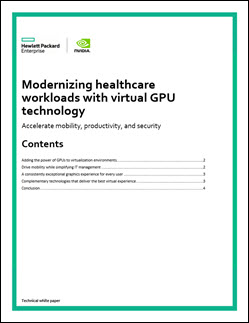Growth in usage of personal devices, such as smartphones or tablets, has caused many to rethink how they deliver IT applications and services to the public. The same goes for the healthcare market when creating apps and products for healthcare professionals. Tackling this challenge, many hospitals have turned to virtualization, and tools like virtual GPUs, to provision many high performance, secure virtual workstations using the compute power of a single physical hardware resource.

Download the full report.
That’s according to a new report from HPE, that explores how virtual GPU technology is helping to modernize healthcare data workloads.
But what are the drivers of this virtualization trend? According to the report, expanding security requirements — especially when it comes to patient data — and the realization that digitization drives efficiency, are both increasing the popularity of virtualization tools.
Think of it this way: It wasn’t long ago that doctors had to take the time to log in and out of dedicated physical workstations to view updated files from patients. Now, virtualization is allowing these same medical professionals to more quickly access this data from any device—no matter where they are.
Now, this may not seem like news. Virtualization has been around for a while. But according to the white paper, hospitals are now looking to incorporate GPUs into their virtual workloads.
[clickToTweet tweet=”Hospitals are incorporating the power of GPUs into their virtual workloads. #virtualization” quote=”Hospitals are incorporating the power of GPUs into their virtual workloads. #virtualization”]
The report explains there are two main uses for GPUs in healthcare. Some are boosting their existing virtualization environment, while others are looking to upgrade their software or deploy new applications. Either way, these healthcare professionals are using GPUs to “reap all the advantages of the latest features these programs should offer.”
Virtual GPUs take this a step further, moving beyond assigning a single GPU to each user, and instead using virtualization to allow sharing.
Virtual GPUs accomplishes this by divvying up a server-based GPU among multiple virtual machines.
The white paper discusses in detail how virtual GPUs can help ensure clinicians can be as mobile as they want to be, while simplifying IT management. Today’s doctors need to be able to access their data from any location, and enabling this type of easy access can positively impact patient care and make it more efficient. In medicine, every second can count. And for IT management, virtual GPUs, of vGPUs, simplify the management of multiple VMs since all resources are managed from a central location.
Further, vGPUs can provide a consistent graphics experience for every user. NVIDIA’s virtual GPU solutions, for example, work to extend the power of their GPUs to virtual workstations, desktops and applications in order to provide a exceptional graphics experience for the most demanding graphics-intensive applications.
Technology partnerships are working to further these fields of deep learning and more, and make tools like virtual GPUs even more powerful. In fact, according to the new report, NVIDIA is partnering with HPE for this very purpose.
NVIDIA and HPE customers can now choose the vGPU software that best matches their needs, while also deploying these software products with NVIDIA Tesla GPU cards installed on HPE server platforms.
Download the full report, “Modernizing healthcare workloads with virtual GPU technology: Accelerate mobility, productivity, and security,” courtesy of HPE.





Speak Your Mind